The Search Assist pop-ups appeared on the Firefox, Chrome, Egde or Internet Explorer without any notice? After that, you are faced with the fact that your internet browser is now rerouted to other intrusive sites and filled with a variety of pop up ads and banners. The cause of all your problems with your system is a browser extension from the adware (sometimes called ‘ad-supported’ software) family. It has been installed on many PC systems around the world without users permission, so you’re one of many. Most probably, you do not even know how and where the Search Assist adware has got into your PC system. In the few simple steps below, we will explain all the general features of Search Assist and its typical behavior on the personal computer, as well as effective ways of removing Search Assist pop ups from the Mozilla Firefox, Chrome, IE and Edge web-browser.
It is likely that you might be worried with the Search Assist responsible for redirecting your internet browser to various unwanted ads. You should not disregard this unwanted software. The adware might not only open undesired advertisements, but reroute your web browser to malicious web-pages. What is more, the Search Assist can analyze your surfing, and gain access to your privacy information and, later, can share it with third-parties. Thus, there are more than enough reasons to get rid of Search Assist extension from your web browsers.
In addition to that, as was mentioned earlier, certain adware to also change all internet browsers shortcut files that located on your Desktop or Start menu. So, every infected shortcut will try to redirect your web-browser to annoying ad sites, certain of which might be malicious. It can make the whole personal computer more vulnerable to hacker attacks.
So, if you happen to encounter annoying pop up ads, then be quick and take effort to remove Search Assist extension which causes undesired ads sooner. Follow the step by step guidance below to get rid of Search Assist pop-ups. Let us know how you managed by sending us your comments please.
How to remove Search Assist extension from Firefox, Chrome, IE, Edge
Without a doubt, the ad-supported software is harmful to your system. So you need to quickly and completely remove the Search Assist adware which redirects your internet browser to annoying ads. To get rid of this ad supported software, you can use the manual removal guide which are given below or free malware removal tool like Zemana, MalwareBytes Free or HitmanPro (all are free). We recommend you use automatic removal method that will allow you to get rid of Search Assist easily and safely. Manual removal is best used only if you’re well versed in computer or in the case where adware is not deleted automatically. Certain of the steps will require you to restart your computer or shut down this site. So, read this guide carefully, then bookmark or print it for later reference.
To remove Search Assist, perform the following steps:
- How to manually remove Search Assist
- Run free malware removal tools to completely remove Search Assist pop-up advertisements
- Run AdBlocker to stay safe online
- How did Search Assist ads get on your PC system
- Finish words
How to manually remove Search Assist
The following instructions is a step-by-step guide, which will help you manually remove Search Assist pop-up ads from the Internet Explorer, FF, Chrome and MS Edge.
Uninstall questionable applications using MS Windows Control Panel
We suggest that you begin the computer cleaning process by checking the list of installed apps and delete all unknown or questionable software. This is a very important step, as mentioned above, very often the malicious apps such as adware and browser hijacker infections may be bundled with freeware. Delete the unwanted software can remove the undesired ads or web-browser redirect.
Make sure you have closed all internet browsers and other software. Press CTRL, ALT, DEL keys together to open the Microsoft Windows Task Manager.

Click on the “Processes” tab, look for something dubious that is the ad supported software which redirects your internet browser to annoying ads then right-click it and select “End Task” or “End Process” option. Most commonly, malicious software masks itself to avoid detection by imitating legitimate Windows processes. A process is particularly suspicious: it’s taking up a lot of memory (despite the fact that you closed all of your programs), its name is not familiar to you (if you are in doubt, you can always check the application by doing a search for its name in Google, Yahoo or Bing).
Next, uninstall any unwanted and suspicious apps from your Control panel.
Windows 10, 8.1, 8
Now, click the Windows button, type “Control panel” in search and press Enter. Select “Programs and Features”, then “Uninstall a program”.
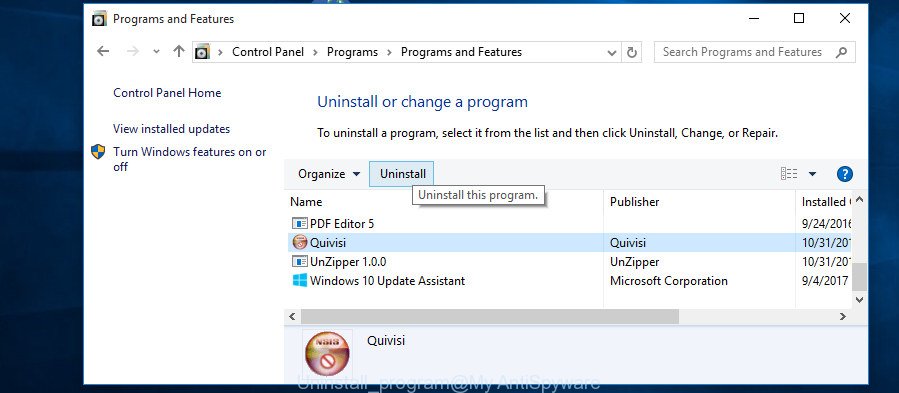
Look around the entire list of apps installed on your computer. Most probably, one of them is the Search Assist adware that causes intrusive popup ads. Select the dubious application or the program that name is not familiar to you and remove it.
Windows Vista, 7
From the “Start” menu in Microsoft Windows, choose “Control Panel”. Under the “Programs” icon, choose “Uninstall a program”.
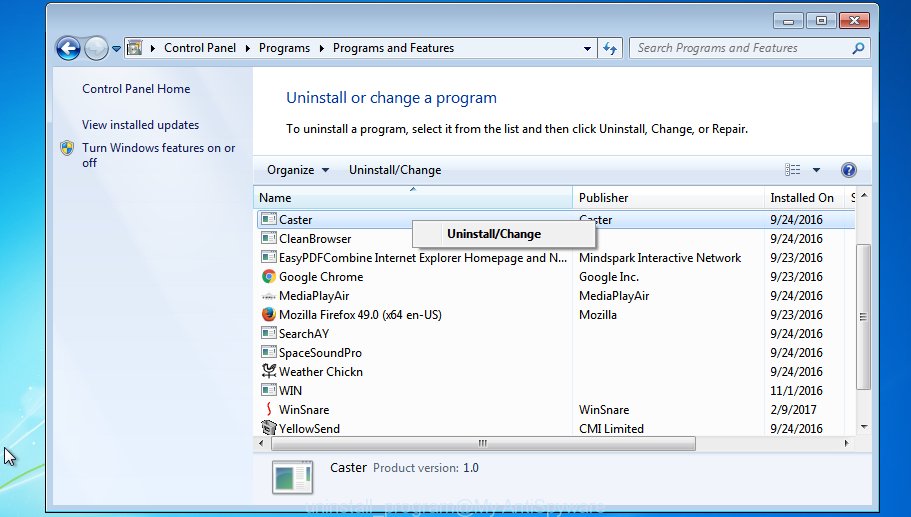
Select the questionable or any unknown applications, then click “Uninstall/Change” button to uninstall this unwanted program from your system.
Windows XP
Click the “Start” button, select “Control Panel” option. Click on “Add/Remove Programs”.
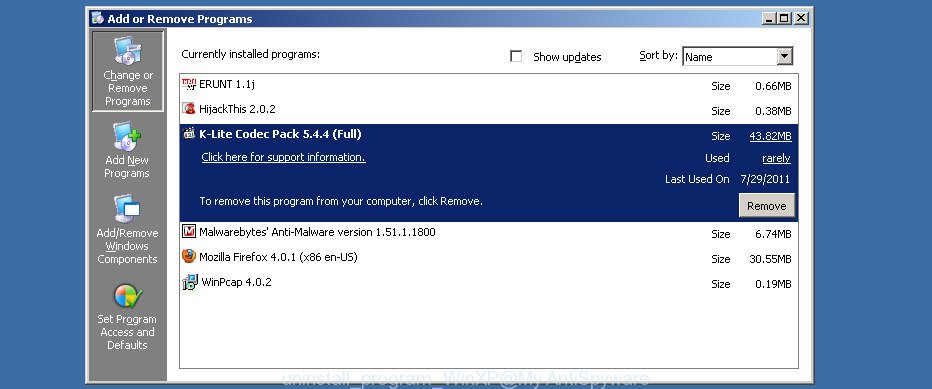
Choose an unwanted program, then click “Change/Remove” button. Follow the prompts.
Get rid of unwanted Scheduled Tasks
If unwanted ads opens automatically on Windows startup or at equal time intervals, then you need to check the Task Scheduler Library and remove all the tasks that have been created by the Search Assist adware.
Press Windows and R keys on your keyboard together. It will show a dialog box that titled as Run. In the text field, type “taskschd.msc” (without the quotes) and click OK. Task Scheduler window opens. In the left-hand side, click “Task Scheduler Library”, as displayed below.
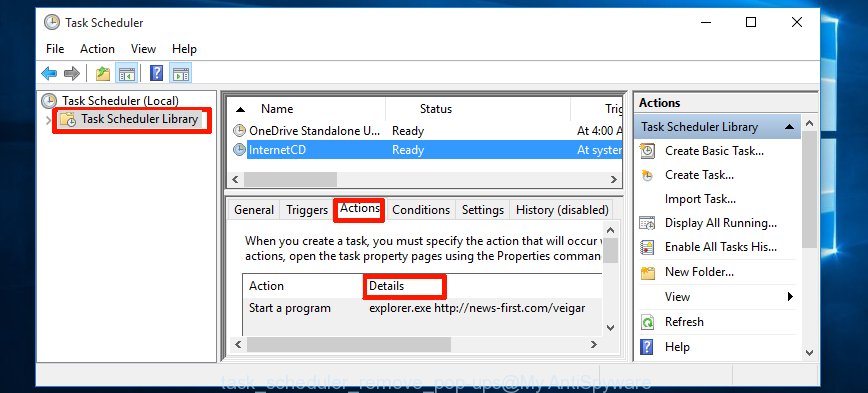
Task scheduler, list of tasks
In the middle part you will see a list of installed tasks. Select the first task, its properties will be show just below automatically. Next, press the Actions tab. Necessary to look at the text which is written under Details. If you are not sure that executes the task, then google it. If it’s a component of the ‘ad-supported’ application, then this task also should be removed.
Further click on it with the right mouse button and select Delete like below.

Task scheduler, delete a task
Repeat this step, if you have found a few tasks that have been created by the Search Assist. Once is finished, close the Task Scheduler window.
Remove Search Assist from Firefox
If the Firefox internet browser program is hijacked, then resetting its settings can help. The Reset feature is available on all modern version of FF. A reset can fix many issues by restoring Firefox settings like search provider, start page and newtab to its default state. It will save your personal information like saved passwords, bookmarks, and open tabs.
Press the Menu button (looks like three horizontal lines), and click the blue Help icon located at the bottom of the drop down menu as shown in the figure below.
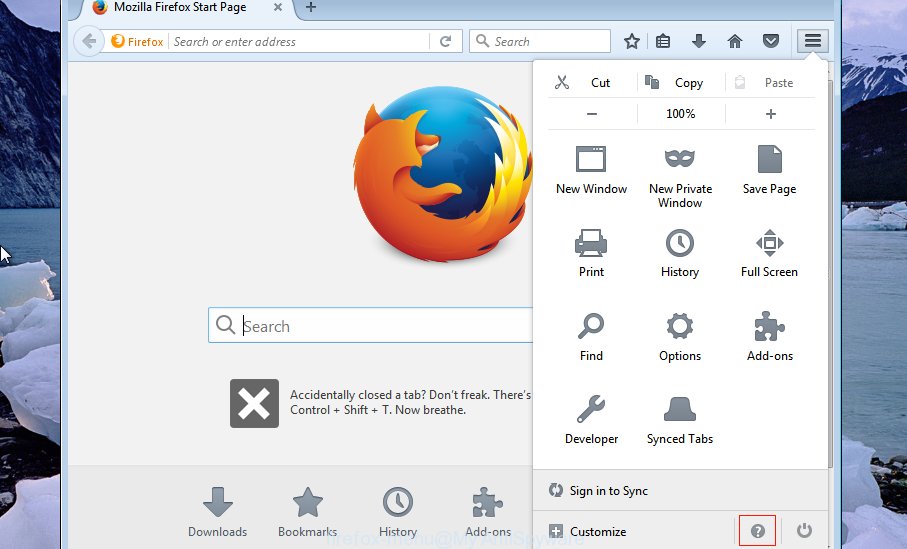
A small menu will appear, click the “Troubleshooting Information”. On this page, press “Refresh Firefox” button as shown in the following example.

Follow the onscreen procedure to restore your Mozilla Firefox browser settings to its original state.
Remove Search Assist pop-up ads from IE
By resetting Microsoft Internet Explorer web browser you restore your browser settings to its default state. This is basic when troubleshooting problems that might have been caused by the Search Assist adware that designed to redirect your web-browser to various ad web pages.
First, open the Microsoft Internet Explorer, then press ‘gear’ icon ![]() . It will open the Tools drop-down menu on the right part of the web browser, then press the “Internet Options” as displayed below.
. It will open the Tools drop-down menu on the right part of the web browser, then press the “Internet Options” as displayed below.

In the “Internet Options” screen, select the “Advanced” tab, then press the “Reset” button. The Internet Explorer will display the “Reset Internet Explorer settings” prompt. Further, click the “Delete personal settings” check box to select it. Next, press the “Reset” button like below.

Once the procedure is done, click “Close” button. Close the Internet Explorer and restart your PC system for the changes to take effect. This step will help you to restore your browser’s default search provider, newtab page and homepage to default state.
Remove Search Assist popups from Chrome
Reset Google Chrome settings is a easy way to remove the hijackers, harmful and ‘ad-supported’ extensions, as well as to recover the browser’s newtab, search provider by default and home page that have been changed by the Search Assist adware.
Open the Google Chrome menu by clicking on the button in the form of three horizontal dotes (![]() ). It will display the drop-down menu. Select More Tools, then press Extensions.
). It will display the drop-down menu. Select More Tools, then press Extensions.
Carefully browse through the list of installed extensions. If the list has the extension labeled with “Installed by enterprise policy” or “Installed by your administrator”, then complete the following steps: Remove Google Chrome extensions installed by enterprise policy otherwise, just go to the step below.
Open the Chrome main menu again, press to “Settings” option.

Scroll down to the bottom of the page and click on the “Advanced” link. Now scroll down until the Reset settings section is visible, as displayed on the image below and click the “Reset settings to their original defaults” button.

Confirm your action, click the “Reset” button.
Run free malware removal tools to completely remove Search Assist pop-up advertisements
Many antivirus companies have developed applications that help detect Search Assist and thereby remove all unwanted pop-up ads from the FF, Internet Explorer, Google Chrome and Edge browsers. Below is a a few of the free applications you may want to run. Your computer can have a lot of PUPs, ad supported software and browser hijacker infections installed at the same time, so we suggest, if any unwanted or malicious program returns after restarting the computer, then run your system into Safe Mode and run the anti malware utility again.
How to remove Search Assist with Zemana Anti-malware
We suggest using the Zemana Anti-malware. You may download and install Zemana Anti-malware to scan for and remove Search Assist extension from the Firefox, Microsoft Edge, Chrome and IE web browsers. When installed and updated, the malware remover will automatically scan and detect all threats exist on your system.

- Visit the page linked below to download Zemana Anti-Malware. Save it on your Microsoft Windows desktop or in any other place.
Zemana AntiMalware
165503 downloads
Author: Zemana Ltd
Category: Security tools
Update: July 16, 2019
- At the download page, click on the Download button. Your browser will display the “Save as” prompt. Please save it onto your Windows desktop.
- When downloading is finished, please close all apps and open windows on your personal computer. Next, run a file named Zemana.AntiMalware.Setup.
- This will open the “Setup wizard” of Zemana Free onto your personal computer. Follow the prompts and do not make any changes to default settings.
- When the Setup wizard has finished installing, the Zemana Free will launch and display the main window.
- Further, click the “Scan” button to perform a system scan for the Search Assist software. Depending on your computer, the scan can take anywhere from a few minutes to close to an hour.
- When the scanning is complete, you will be shown the list of all found items on your PC system.
- You may remove threats (move to Quarantine) by simply click the “Next” button. The utility will begin to remove Search Assist and other unwanted software. After finished, you may be prompted to reboot the personal computer.
- Close the Zemana AntiMalware and continue with the next step.
Get rid of Search Assist pop up ads and malicious extensions with Hitman Pro
HitmanPro is a free removal tool. It removes potentially unwanted applications, ad-supported software, hijackers and unwanted browser extensions. It will identify and get rid of Search Assist adware that causes browsers to show annoying pop-up ads. Hitman Pro uses very small personal computer resources and is a portable application. Moreover, Hitman Pro does add another layer of malware protection.
Visit the page linked below to download the latest version of Hitman Pro for Windows. Save it on your Desktop.
After the download is finished, open the file location and double-click the HitmanPro icon. It will start the Hitman Pro tool. If the User Account Control prompt will ask you want to start the program, click Yes button to continue.
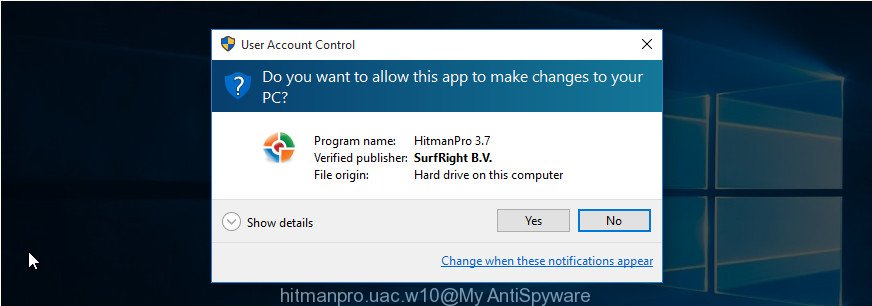
Next, press “Next” for scanning your PC system for the Search Assist adware responsible for redirecting your web browser to various ads. While the utility is scanning, you can see number of objects and files has already scanned.
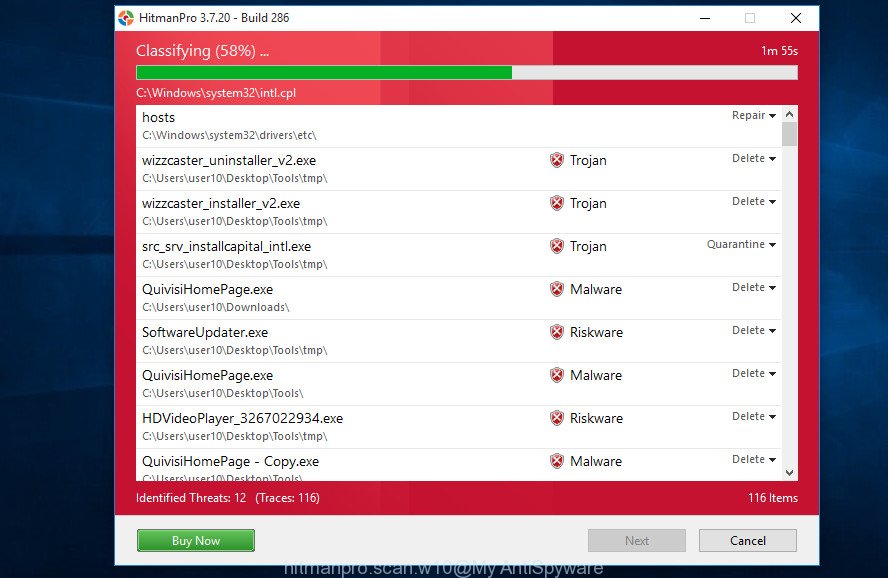
Once the scan get finished, a list of all items found is created as displayed in the figure below.
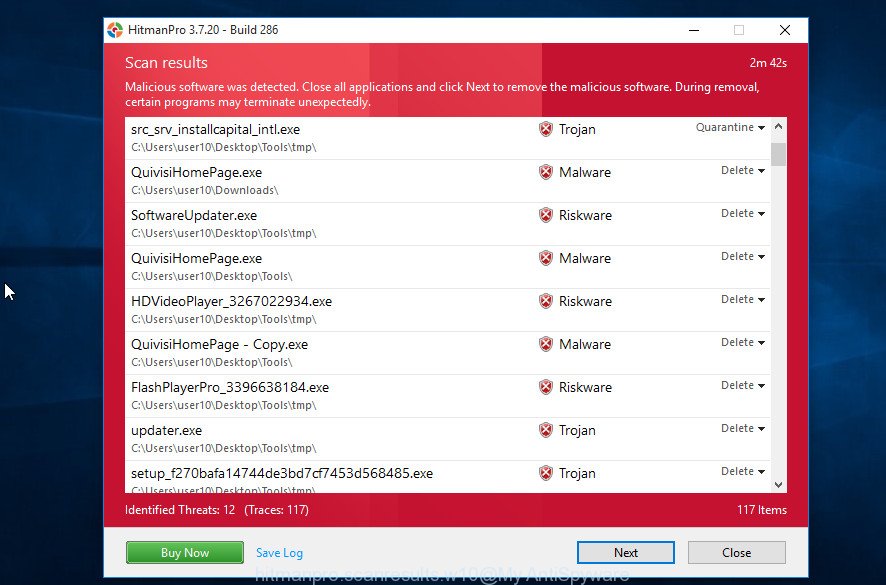
Once you’ve selected what you want to get rid of from your computer click “Next” button. It will display a prompt, press the “Activate free license” button. The HitmanPro will start to remove Search Assist adware. When the clean-up is finished, the tool may ask you to reboot your computer.
Run Malwarebytes to remove Search Assist advertisements
Manual Search Assist pop-up ads removal requires some computer skills. Some files and registry entries that created by the ad supported software may be not completely removed. We suggest that run the Malwarebytes Free that are completely free your personal computer of adware. Moreover, the free program will help you to get rid of malicious software, PUPs, browser hijackers and toolbars that your computer can be infected too.
Click the link below to download the latest version of MalwareBytes Anti-Malware (MBAM) for MS Windows. Save it on your Desktop.
327724 downloads
Author: Malwarebytes
Category: Security tools
Update: April 15, 2020
Once the downloading process is finished, close all apps and windows on your PC system. Open a directory in which you saved it. Double-click on the icon that’s called mb3-setup like below.
![]()
When the install begins, you’ll see the “Setup wizard” that will help you install Malwarebytes on your machine.
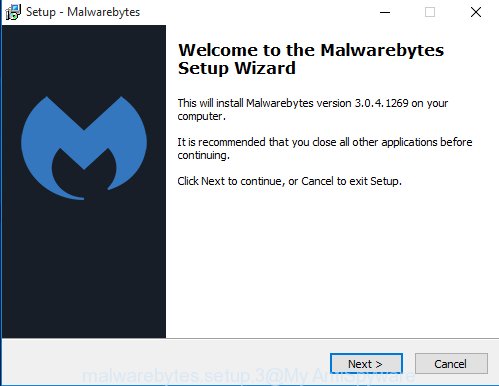
Once installation is finished, you’ll see window as displayed below.
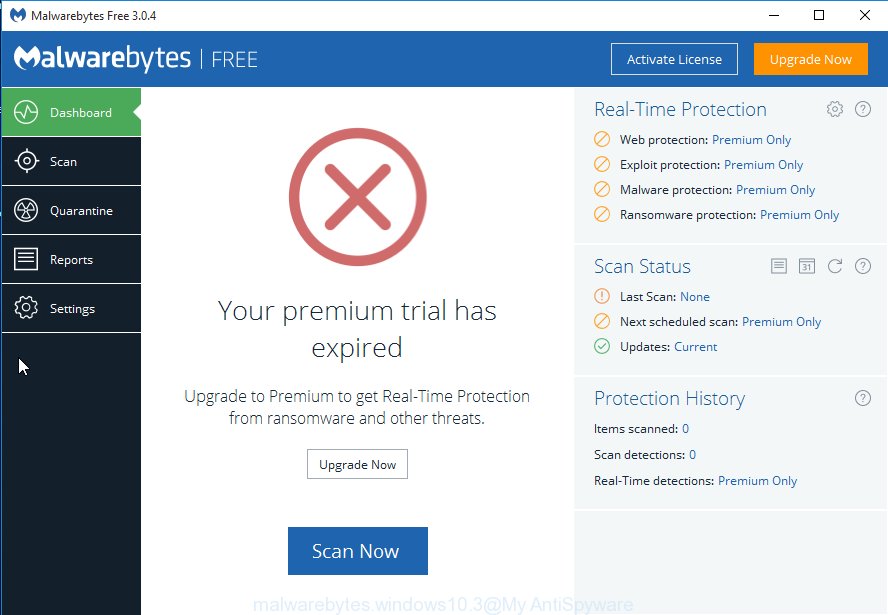
Now press the “Scan Now” button . MalwareBytes Free program will scan through the whole PC system for the Search Assist adware. A scan can take anywhere from 10 to 30 minutes, depending on the count of files on your system and the speed of your computer. While the MalwareBytes AntiMalware (MBAM) application is checking, you may see count of objects it has identified as threat.
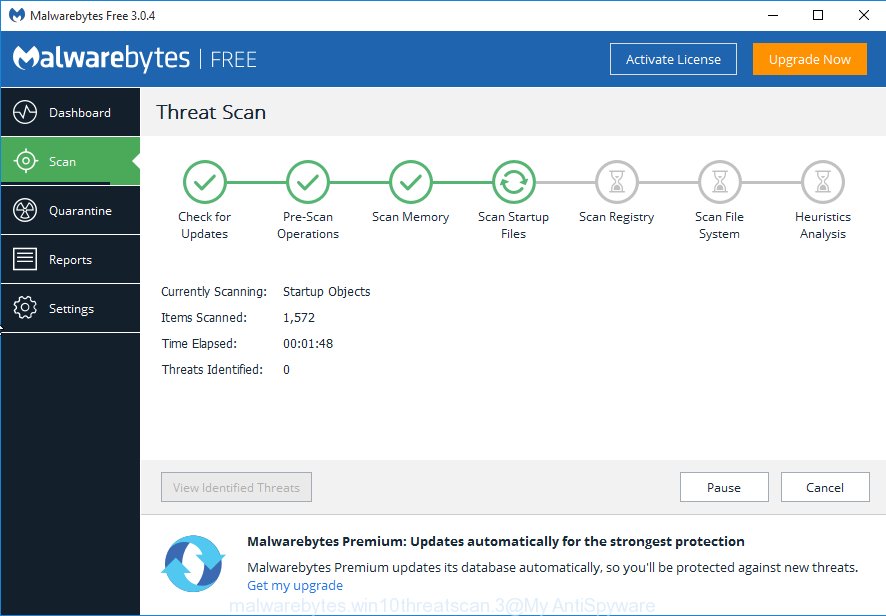
When that process is finished, MalwareBytes Free will open a list of all threats detected by the scan. All detected items will be marked. You can remove them all by simply click “Quarantine Selected” button.
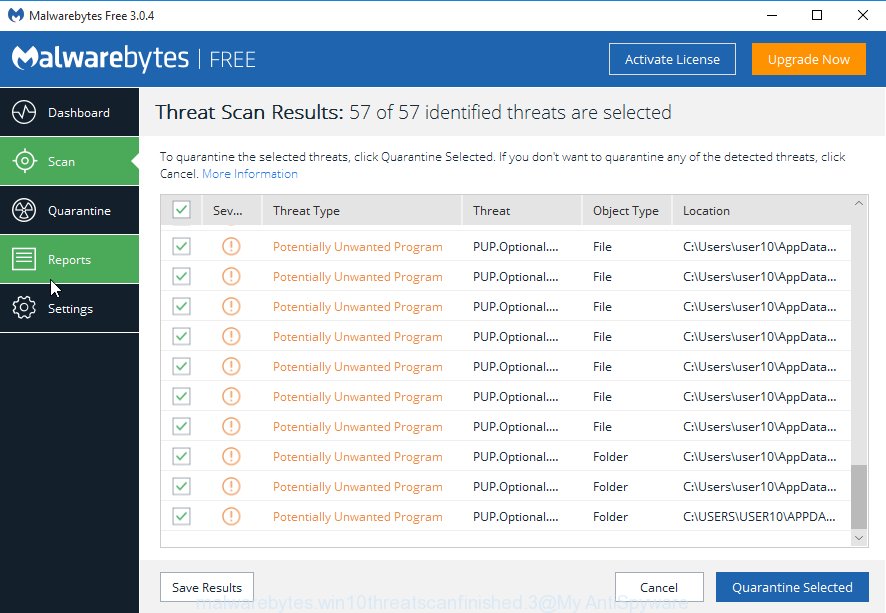
The Malwarebytes will now start to delete Search Assist software. Once finished, you may be prompted to reboot your computer.

The following video explains step by step guidance on how to delete hijacker, adware and other malicious software with MalwareBytes Anti Malware.
Run AdBlocker to stay safe online
The AdGuard is a very good ad-blocker program for the Microsoft Edge, Firefox, Chrome and Microsoft Internet Explorer, with active user support. It does a great job by removing certain types of annoying ads, popunders, popups, annoying newtabs, and even full page advertisements and web-site overlay layers. Of course, the AdGuard can block all unwanted popup advertisements automatically or by using a custom filter rule.
AdGuard can be downloaded from the following link. Save it on your Microsoft Windows desktop or in any other place.
27036 downloads
Version: 6.4
Author: © Adguard
Category: Security tools
Update: November 15, 2018
After downloading it, launch the downloaded file. You will see the “Setup Wizard” screen as shown on the image below.

Follow the prompts. When the installation is finished, you will see a window as shown on the screen below.

You can click “Skip” to close the installation program and use the default settings, or click “Get Started” button to see an quick tutorial which will help you get to know AdGuard better.
In most cases, the default settings are enough and you don’t need to change anything. Each time, when you launch your system, AdGuard will start automatically and block popup ads, as well as other malicious or misleading web sites. For an overview of all the features of the program, or to change its settings you can simply double-click on the AdGuard icon, which is located on your desktop.
How did Search Assist get on your PC system
The Search Assist spreads with a simple but quite effective way. It is integrated into the installer of various free programs. Thus on the process of install, it will be installed onto your system. In order to avoid adware, you just need to follow a few simple rules: carefully read the Terms of Use and the license, select only a Manual, Custom or Advanced install mode, which enables you to make sure that the program you want to install, thereby protect your PC from the ‘ad supported’ software that causes multiple annoying popup ads.
Finish words
Now your computer should be clean of the Search Assist adware. We suggest that you keep Zemana (to periodically scan your PC for new ‘ad supported’ softwares and other malware) and AdGuard (to help you stop unwanted pop up advertisements and malicious web pages). Moreover, to prevent any ad-supported software, please stay clear of unknown and third party programs, make sure that your antivirus program, turn on the option to find potentially unwanted apps.
If you need more help with Search Assist pop up advertisements related issues, go to our Spyware/Malware removal forum.


















